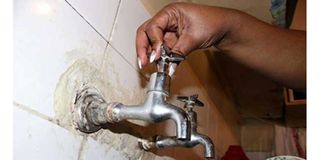Premium
Kisumu stares at water shortage as reservoir levels drop

The main water plant in Kisumu, Kajulu Water Treatment Plant at River Kibos is currently operating below its production capacity and residents might soon start having dry taps if the dry weather persists.
A water shortage is looming in Kisumu following concerns over the reducing levels at the main reservoir at River Kibos in Kajulu.
If the trend continues, most parts of Kisumu City will have dry taps in the coming weeks, at a time when the country is battling a serious drought.
An announcement by Kisumu Water and Sanitation Company (Kiwasco) noted that the prolonged drought being experienced in most parts of the country has led to reduction of water in dams.
Some of the areas that are likely to be affected are Kanyamedha, Otonglo, Tiengre, Uzima, Mamboleo, Guba, Lolwe, Migosi and parts of Riat.
According to Kiwasco Managing Director Thomas Odongo, Kajulu Water Treatment Plant, which gets water from River Kibos, is currently operating below its production capacity.
"This is as a result of low water levels from the river caused by the prolonged drought currently being experienced in most parts of the country due to the global climate change effects," he said.
The disruption will leave Kiwasco relying on its main water treatment plant at Dunga, which draws water from Lake Victoria.
He warned that residents supplied by the Kajulu Treatment Plant will experience water rationing.
"The company has, however, stepped up maximum production from Dunga Water Treatment Plant to ensure that we equitably serve our customers," said Mr Odongo.
Despite having a capacity of 15,000 cubic metres a day, the Dunga raw water intake and treatment plant, which was designed for a population of 15,000 has not been performing optimally.
The colonial-era facility is one of the projects earmarked for rehabilitation in a move aimed at improving sanitation and ensuring safe drinking water in Kisumu.
"We shall institute a distribution schedule if the situation persists and may also introduce a water supply programme using water bowsers. Help us to conserve the available supply by minimising wastage and using water sparingly,” he said.
In the Guba area, some residents have resorted to drawing water from the river after water rationing started in the area.
Mary Otieno, a resident of Guba, said already, water vendors have started taking advantage of the warning by the water provider and have increased the price of water.
"Initially, the price of a 10-litre jerry can would be Sh5, but it has shot to Sh10 and the 20-litre one was at Sh10 but it has increased to Sh20," said Mrs Otieno.
James Omondi, another resident, said during the dry spell, people have to walk long distances to get water from River Kibos.
"As the population increases, the water demand also increases, not only for domestic use but for the keeping of livestock," said Mr Omondi.
Meanwhile, Kiwasco management has urged residents to conserve the environment by planting trees and practising environmentally friendly activities to preserve natural sources.






